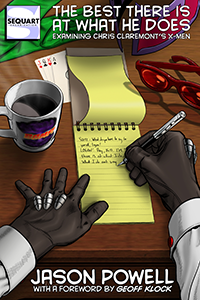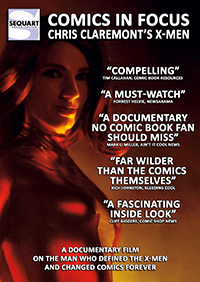Colleen Wing, the samurai detective who formed one half of the investigative agency Nightwing Restorations Ltd. with Misty Knight, is a complex and vastly underrated character. Created in 1974 by Doug Moench and Larry Hama during their Iron Fist run in Marvel Premiere, Colleen didn’t fully blossom until Chris Claremont took over the reins of the story with issue #23. Soon after, Claremont and artist John Byrne transitioned over to Iron Fist, where the martial arts master’s story continued across the series fifteen-issue run. Claremont and Byrne’s time on Iron Fist is the stuff of legend and offers an early glimpse at the lightning in a bottle the two would achieve with Uncanny X-Men soon after. One of the hallmarks of their run on Uncanny is their cast of strong and intelligent women. Colleen—and her fellow Daughter of the Dragon, Misty—fits perfectly alongside those other powerful Claremont women. She was in many ways one of the earliest examples of “the Claremont woman.”
Colleen’s first few appearances were inconsistently written. Some of the parts were there for a great character but they weren’t yet assembled in the right order. Even the artists and colorists seemed to be experimenting with the character, as in one issue her hair was jet black with blue highlights and in the next it was chestnut brown. Then Claremont took over and during his time writing Iron Fist would build Colleen into a force to be reckoned with. An expert swordswoman and samurai, Colleen was also a skilled investigator whose mastery of chi granted her enhanced strength and accelerated healing. She was in many ways a kindred spirit to Danny Rand’s Iron Fist, as the two shared a bond over their martial arts expertise. They would later be further linked when Danny melded minds with Colleen in order to save her from the clutches of the evil Master Khan, who had turned Colleen into a mind-controlled slave.
That last plot point highlights a few other Claremont ticks: mind control shenanigans crop up often in his stories, as well as seemingly confident and independent women needing to be rescued (sometimes by men) from said mind control. While Claremont’s reputation as a champion of female characters is well deserved, it’s also worth noting that at times it almost seemed as if he was trying to tear them down in order to rebuild them. Any writer might want to do this in order to heighten the dramatic intensity of their work. Colleen, under Claremont’s direction, was clearly a self-sufficient woman who could handle herself in a fight. Yet Claremont’s tendency to allow her to fall under the sway of mind control—or be drugged into subservience by a heinous crime lord in a tale he wrote for Deadly Hands of Kung Fu—was troublesome. Again, Colleen is not unique to this trope: numerous Claremont women—and also men—fell prey to mind control over the years. It was a standard plot device he returned to often, likely because it allowed for him to explore various issues related to the insidious violation of a character’s mind (and sometimes body) in these situations.
Yet in bringing Colleen low during the Master Khan arc, Claremont and Byrne were then able to build to an immensely satisfying and expertly crafted moment for the character. Khan had enlisted the little-used character Angar the Screamer to destroy the mind of Colleen’s father, Professor Lee Wing, and to mind-control Colleen. Once free of this submissive state, Colleen took vengeance on Angar in a beautifully executed nine-panel sequence that stands out as some of the most powerful work of Byrne’s career.
Angar taunts Colleen, threatening to “blow [her] mind away,” just like he did to her father. Before he can utilize his vocal hallucination power to do so, Colleen strikes fast. With one split-second stroke of her sword, she puts an end to Angar’s reign of terror. At first he doesn’t even feel the mortal wound, but as Collen assures him, “I didn’t miss, Angar.” Once he feels it, Angar utters only, “Oh” before slumping to the floor. The scene appears to indicate Colleen slayed Angar, but this being comics, the Screamer would return. Still, that doesn’t dilute the impact of this scene in the slightest. Claremont’s dialogue is crisp and direct, with no narration boxes to clutter things up and allowing Byrne’s art room to breathe. Byrne’s plotting is impeccable here, especially in the middle four panels. He shows us Angar’s face as the villain boasts of Colleen having missed, followed by a shot of Colleen’s empty scabbard, then Colleen’s resolute response to Angar’s taunt, then her bloody sword, and concludes with Angar’s sudden realization that he has indeed been gutted. It’s a masterful job of stroytelling by Claremont and Byrne, a perfect example of how well the two worked together when they were each firing on all cylinders. It’s also, without question, one of the most bad-ass scenes in Marvel Comics from that era, and likely from any era. It’s a star-making moment for Colleen, one that plays off the 1970s revenge fantasy trends, and in this case provides an extremely satisfying conclusion to the typical victim-versus-abuser story line.
Moments like that made Colleen Wing a tremendously exciting and vibrant supporting character in the world of Iron Fist and eventually beyond. It’s during these issues, written by Chris Claremont and illustrated by John Byrne, that the first attempts were made at fully fleshing out Colleen’s character and motivations. Claremont and Byrne were building something special over the course of this run, and in Colleen they provided a perfect example of what would come to be known as “the Claremont woman:” she’s fiercely self-sufficient, extremely intelligent, highly skilled, and in a fight she only needs herself and her weapon or powers to mete out the appropriate level of justice. Iron Fist may have helped Colleen break free of her hallucinatory submissive state, but she made Angar pay for his violation of her mind. During this combined run in Marvel Premiere and Iron First—plus a few issues of Marvel Team-Up that tied things up after the cancellation of Iron Fist—Colleen Wing grows into a character of substance, one that will continue to play an important role in various Marvel series up to the present day. Claremont and Byrne deserve credit for the realizing the character’s potential early on.





















































